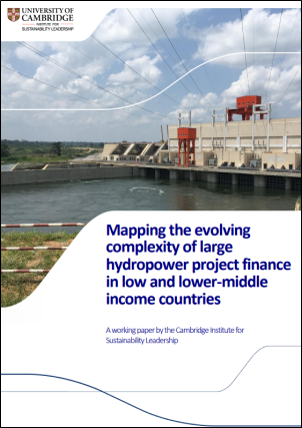This paper is the second in a series of working papers emerging from the CISL’s contribution to the FutureDAMS project, with a specific focus on the questions around sustainable finance for sustainable hydropower projects in developing countries.
Hydropower has a specific role to play in the broader context of sustainable development, particularly, but not exclusively in improving energy access. The financing options available for emerging economies affect the way these countries are able to utilise their natural resources for social and economic development, including progress towards the Sustainable Development Goals (SDGs).
This paper traces the evolution and complexity of hydropower financing from the early 1970s to the present day, showing how the types and roles of various actors have changed over time and how new types of financing packages have surfaced to meet the growing need for large energy infrastructure projects in emerging economies.
The paper focuses on the three main structures of hydropower project financing in emerging economies: public, public-private-partnership (PPP), and new bilateral finance. Projects developed through PPPs often involve a complex mix of investors and lenders from both public and private sectors, as well as guarantees from multilateral development banks and other risk mitigation measures. New forms of bilateral financing arrangements such as that provided by China Exim Bank, tend to require fewer actors, but come with constraints and risks, such as the absence of safeguards and increased government debt for the countries that access them.
The changes in hydropower finance over time have been influenced by the broader political and economic context characterised by reduced availability of public sector funds, the sustainable development imperative, and the rise of new actors such as China and South Korea as key players in the global economic and political stage. This paper seeks to provide the foundation and background for discussion of hydropower finance in a historical and comparative perspective. Examples from emerging economies are used to contextualise the variation in the ‘typical’ features of the different financing frameworks, as well as their relative strengths and limitations.
About
This paper was prepared with financial support from the UKRI Global Challenges Research Fund under a project called ‘FutureDAMS’ (ES/P011373/1). The FutureDAMS consortium comprises some 30 researchers across various universities and research institutes working to improve the design, selection and operation of dams to support sustainable development. More information about the FutureDAMS project is available here.
Citing this report
Cite this paper as: Plummer Braeckman, J., Markkanen, S. and Souvannaseng, P. (2019) Mapping the evolving complexity of large hydropower project finance in emerging economies. FutureDAMS Working Paper The University of Manchester and University of Cambridge Institute for Sustainability Leadership.




